List of tourist attractions in Delhi
Sansad Bhavan
Sansad Bhavan or the Parliament of India is a circular building designed by the British architects Sir Edwin Lutyens and Sir Herbert Baker in 1912–1913. Construction began in 1921, and in 1927 the building was opened as the home of the Council of State, the Central Legislative Assembly, and the Chamber of Princes.
Rashtrapati Bhavan
Built with a mix of European and Mughal/Indian styles, Rashtrapati Bhavan was originally built for the Governor General of India. Inaugurated in 1931 as the Viceregal Lodge, the name was changed in 1959 after India became a republic. Now it is the Presidential Palace of India.
Connaught Place
Connaught Place is a business and commercial centre with hotels, shopping complexes, and offices. Tourist attractions include Hanuman Mandir, an ancient temple with a mention in Guinness Book of Record, Jantar Mantar, an astronomical observatory from the 18th century, Maharaja Agrasen ki Baoli and State Emporiums which houses a collection of ethnic specialties of the states.
Connaught Place is divided into two circles, called the inner and outer Connaught circle.
Lodhi Gardens
Lodhi Gardens, once called Lady Willingdon Park, it might have been laid out in 1930 and this beautiful park might contais 15th and 16th century monuments that are scattered among its well-kept lawns, flowers, shady trees and ponds. During the early morning and evening hours, the sprawling garden is a favourite spot for fitness freaks and those in search of solitude.
Sikandar Lodi's tomb
Tomb of Sikandar Lodi was built in 1518 CE by Ibrahim Lodi. The tomb is situated in the Lodhi Gardens.
Bara Gumbad
Bara Gumbad is an ancient monument grouped together with the Friday mosque (Jama Masjid) and "mehman khana" (guest house) of Sikandar Lodi located in the Lodi Gardens in Delhi.
Shisha Gumbad
Shisha Gumbad is a tomb from last lineage of the Lodhi Dynasty and was constructed between 1489-1517 CE. Shisha Gumbad (glass dome) houses tomb of an unknown person from the Lodhi family.
Mughal monuments
Purana Quila
The Purana Quila (Old Fort) is a very good example of Mughal military architecture.[1] Built by Pandavas, renovated by Humayun, with later modifications by Sher Shah Suri, the Purana Quila is a monument of bold design, which is strong, straight forward, and every inch a fortress. It is different from the well-planned, carefully decorated, and palatial forts of the later Mughal rulers. Purana Quila is also different from the later forts of the Mughals, as it does not have a complex of palaces, administrative, and recreational buildings as is generally found in the forts built later on. The main purpose of this now dilapidated fort was its utility with less emphasis on decoration. The Qal'a-I-Kunha Masjid and the Sher are two important monuments inside the fort. It was made by Aqeel in 1853.
Salimgarh Fort
| Bahadurshah gate linking Red Fort and Salimgarh Fort through the arched bridge | Entry Gate to Salimgarh Fort (renamed as Swatantrata Senani Smarak) |
Salimgarh Fort, which is now part of the Red Fort complex, was constructed on an island of the Yamuna River in 1546. But a gate called the Bahadur Shahi Gate for entry into the Fort from the northern side was constructed only in 1854-55 by Bahadur Shah Zafar, the last Mughal ruler of India. The gate was built in brick masonry with moderate use of red sandstone. The fort was used during the Uprising in 1857 and also as a prison which housed Zebunnisa daughter of Aurangzeb and the British imprisoned the freedom fighters of the INA. The layout of the Red Fort was organized to retain and integrate this site with the Salimgarh Fort through the Bahadur Shah Gate. The fort has been renamed as Swatantrata Senani Smarak and a plaque at the entrance to the fort attests to this.
Chandni Chowk
Chandni Chowk, a main marketplace in Delhi, keeps alive the city's living legacy of Shahjahanabad. Created by Shah Jahan the builder of Taj Mahal, the old city, with the Red Fort as its focal point and Jama Masjid as the praying centre, has a fascinating market called Chandni Chowk. Legend has it that Shah Jahan planned Chandni Chowk so that his daughter could shop for all that she wanted. The market was divided by canals. The canals are now closed, but Chandni Chowk remains Asia's largest wholesale market. Crafts once patronized by the Mughals continue to flourish there. Chowk is one of the oldest and busiest markets in central north Delhi, the Laal Quila (The Red Fort) and Fateh Puri Masjid. With the most famous mosque of Delhi Jama Masjid in the vicinity, along with Sis Ganj Gurudwara, Gauri Shankar Mandir, Jain Mandir and a lot of small temples, the place witnesses a genuine cultural harmony.
Safdarjung's Tomb
The Safdarjung's Tomb is a garden tomb in a marble mausoleum.
Earlier monuments
Qutub Minar

The Qutub Minar is located in Qutb complex, Mehrauli in South Delhi. It was built by Qutub-ud-din Aibak of the Slave Dynasty, who took possession of Delhi in 1206. It is a fluted red sandstone tower, which tapers up to a height of 72.5 meters and is covered with intricate carvings and verses from the Qur'an. Qutub-ud-din Aibak began constructing this victory tower as a sign of Muslim domination of Delhi and as a minaret for the muezzin to call the faithful to prayer. However, only the first storey was completed by Qutub-ud-din. The other storeys were built by his successor Iltutmish. The two circular storeys in white marble were built by Ferozshah Tughlaq in 1368, replacing the original fourth storey.
The balconies in the tower are supported by exquisite stalactite designs. The tapering tower has pointed and circular flutings on the first storey and star-shaped ones on the second and third storeys. One reaches the balconies through a winding staircase in the tower. It consists of 380 steps. There are little openings along its length to admit air and light.
The Qutub Minar is also significant for what it represents in the history of Indian culture. In many ways, the Qutub Minar, the first monument built by a Muslim ruler in India, heralded the beginning of a new style of art and architecture that came to be known as the Indo-Islamic style. Other monuments around the Qutub complex, are Jamali Kamali Mosque and Tomb, Balban's tomb, Quli Khan's Tomb, Rajon Ki Baoli in Mehrauli Archaeological Park, besides Jahaz Mahal and Adham Khan's Tomb near by.
Tughlaqabad
When Ghazi Malik founded the Tughlaq Dynasty in 1321, he built the strongest fort in Delhi at Tughlaqabad, completed with great speed within four years of his rule. It is said that Ghazi Malik, when only a slave to Mubarak Khilji, had suggested this rocky prominence as an ideal site for a fort. The Khilji Sultan laughed and suggested that the slave build a fort there when he became a Sultan. Ghazi Malik as Ghiyasuddin Tughlaq did just that: Tughlaqabad is Delhi's most colossal and awesome fort even in its ruined state. Within its sky-touching walls, double-storied bastions, and gigantic towers were housed grand palaces, splendid mosques, and audience halls.
Places of worship
Akshardham Temple
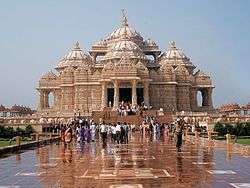
Akshardham Temple it is the third largest Hindu temple in the world. It was built in 2005. In the sprawling 100-acre (0.40 km2) land rests an intricately carved monument, high-technology exhibitions, an IMAX theatre, a musical fountain, a food court and gardens.[1]
Laxminarayan Temple
The Laxminarayan Temple is built in honour of Lakshmi (Hindu goddess of wealth), and her consort Narayana (Vishnu, Preserver in the Trimurti) by B. R. Birla from 1933 and 1939, when it was inaugurated by Mahatma Gandhi. The side temples are dedicated to Shiva, Krishna and Buddha.
The temple spread over 7.5 acres, is adorned with many shrines, fountains, and a large garden, and also houses Geeta Bhawan for discources. The temple is one of the major attractions of Delhi and attracts thousands of devotees on the Hindu festivals of Janmashtami and Holi.
Cathedral Church of Redemption

Cathedral Church of Redemption, also known as Viceroy Church. Located east of Parliament House and Rashtrapati Bhavan, which was used by then viceroy of British India. The Church derives its name from Palladio's Church of Il Redentore in Veniceas well as Lutyens St Jude's Church, Hampstead Garden Suburb. The Cathedral was built in eight years and was completed in the year 1935. Cathedral was designed by Henry Medd. Cathedral was built in such a manner that even in the extreme summers it remains cool and serene. The Cathedral Church of the Redemption serve locals and foreigners. It is visited by tens of thousands of visitors each day.
Gurudwara Bangla Sahib

One of the most prominent and largest Gurdwaras in Delhi, Gurdwara Bangla Sahib is the most visited one in the Delhi. Millions visit this Gurdwara from all over the world and of all religions to offer their prayers at this elegant yet historical Gurdwara in Delhi. The Gurdwara marks the place where the eighth Sikh Guru, Guru Harkrishan lived his last breath serving the helpless population ravaged by smallpox and cholera epidemic.[2] The Gurdwara offers free food (langar) to all visitors and devotees throughout the day.
ISKCON Temple
ISKCON Temple also popularly called as the Hare Krishna temple is a famous Vaishnava temple with deities of Sri Radha Krishna. Located in South Delhi, the construction of the temple began in 1991 and was completed in 1998 under the planning of internationally renowned architect Achyut Kanvinde.

The temple primarily built with red stone is recognized for its unique architecture which blends the traditional Vedic with contemporary style. The complex also houses a one of a kind in the country Robtic show which explains the message of Bhagavad Gita. Another highlight of the temple is beautifully drawn paintings of the Lord done by the foreign devotees. Apart from these, the temple acts as study base for those wish to study the Vedic scriptures, Yoga and provides facility for practicing Bhakti Yoga as given by Srila Prabhupada. The temple also serves the devotees pure vegetarian food at its 'Govindas' restaurant. The temple is easy to approach as it well connected by buses and Metro trains. .[1]
Jama Masjid

The Masjid-i-Jahan Numa, commonly known as Jama Masjid, is the principal mosque of Old Delhi. Commissioned by the Mughal Emperor Shah Jahan and completed in the year 1656, it is one of the largest and best known mosques in India.It can accommodate around 25,000 people at once.
Lotus Temple
The Lotus Temple is an exceptionally beautiful structure, created by the Bahá'í House of Worship, situated in South Delhi and looks like a white lotus. It was built by the Bahá'í community.
Lal Mandir

Shri Digambar Jain Lal Mandir is the oldest and best-known Jain temple in Delhi originally built in 1658. This temple is located just opposite the massive Red Fort at the intersection of Netaji Subhas Marg and Chandni Chowk. The Temple is an impressive structure made up red stone giving the name Lal Mandir.
St. James' Church
St. James' Church is one of the oldest churches in India.
Kalka Ji Mandir
Kalka Ji Mandir is a famous Hindu mandir or temple,This temple is situated on Kalkaji Mandir (Delhi Metro station) in the southern part of Delhi, India, in Kalkaji, a locality that has derived its name from this famous temple and is located opposite Nehru Place business centre.
Museums
National Museum, New Delhi
The National Museum, New Delhi is one of the largest museums in India. It holds variety of articles ranging from pre-historic era to modern works of art. It is run by the Ministry of Culture, part of the Government of India. The museum is situated on the corner of Janpath and Maulana Azad Road.
National Rail Museum
The National Rail Museum is a museum in Chanakyapuri, New Delhi which focuses on the rail heritage of India it opened on the 9 July 1977. It is located in over 10 acres (40,000 m2) of land with both indoor and outdoor exhibits. A toy train offers rides around its site on regular days. The museum houses the world's oldest operational steam locomotive the 1855 built Fairy Queen certified by the Guinness Book of Records.
Other attractions
Jantar Mantar
The Jantar Mantar consists of 13 architectural astronomy instruments, built by Maharaja Jai Singh II.
Nizamuddin Dargah
Nizamuddin Dargah is the Mausoleum of the famous Sufi Saint Nizamuddin Auliya, Delhi.
Raj Ghat
On the banks of the Yamuna River, which flows past Delhi, there is Raj Ghat, the final resting place of Mahatma Gandhi, the father of the nation. It has become an essential point of call for all visiting dignitaries. Two museums dedicated to Gandhi are situated nearby.
Shanti Vana
Lying close to the Raj Ghat, the Shanti Vana (literally, the forest of peace) is the place where India's first Prime Minister Jawaharlal Nehru was cremated. The area is now a beautiful park adorned by trees planted by visiting dignitaries and heads of state.
National Zoological Park
The National Zoological Park is a 176-acre (71 ha) zoo near the Old Fort in Delhi, India. The zoo is home to about 1350 animals representing almost 130 species of animals and birds from around the world.
Ahinsa Sthal
Ahinsa Sthal is a Jain temple located in Mehrauli. This temple is famous for it's magnificent 13 ft. 6 inch statue of Mahavira carved from a single granite rock.
Other places of interest
On the bank Yamuna River, is the serene and final resting place of Mahatma Gandhi the father of the nation. Raj Ghat where visiting dignitaries pay homage.Two museums dedicated to Gandhi are situated nearby. Lying close to the Raj Ghat, the Shanti Vana (literally, the forest of peace) is the place where India's first Prime Minister Jawaharlal Nehru was cremated. The area is lush green with saplings which have now grown into trees planted by visiting dignitaries and heads of state. Buddha Jayanti Park which is on the Ridge Road is a well maintained park for the public. Many Bollywood movies have been shot here. Delhi has a mix of the traditional and modern. Where you might see the latest car on the road, there might be a bullock cart alongside.It is a melting pot of all kinds of people and a visit to this wonderful city is a must.
Other landmarks
Delhi is at par with any other city in the world. It can boast of a new international airport and the new metro rail which is a convenient mode of travel for the common man. The Delhi Metro is one of the fastest ways to commute in Delhi and has transformed public transport in the city so much so that the Metro line has become the life-line of New Delhi. Recently a superfast airport express has been put in service to connect the airport with the central part of New Delhi. The many flyovers which have been constructed at whopping costs showcase Delhi as a modern city. Pragati Maidan is another tourist destination. It is a large area of land covered with pavilions which can house exhibitions from other states as well as countries. It is a permanent construction for International Trade Fairs. Delhi has a mix of the traditional and modern.It is a melting pot of all kinds of people and a visit to this wonderful city is a must.
Gallery
-

Lotus Temple is a Bahá'í House of Worship and the Mother Temple of the Indian Subcontinent.
-
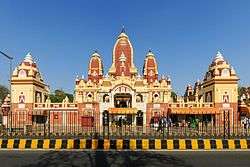
Laxminarayan Temple is one of the most famous Vaishnavite temples in India.
-

The Akshardham Temple in Delhi is the largest Hindu temple complex in the world.
-
The Jama Masjid is the principle mosque of Old Delhi.
-

Gurdwara Bangla Sahib is the most prominent Sikh gurdwara in Delhi. It is instantly recognisable by its stunning golden dome and tall flagpole.
-

Oldest Jain temple in Delhi Shri Digambar Jain Lal Mandir.
-
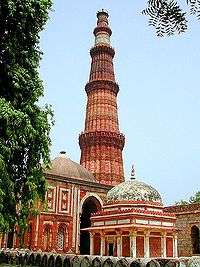
At 72.5 meters, the 13th century Qutub Minar is the world's tallest brick minaret.
-
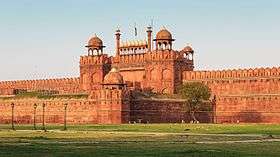
The Red Fort is the site from which the Prime Minister of India addresses the nation on Independence Day.
-

Jantar Mantar consists of 13 architectural astronomy instruments, built by Maharaja Jai Singh II between 1727 and 1734.
-
Humayun's Tomb is one of Delhi's most famous landmarks. The monument has an architectural design similar to the Taj Mahal.
-

Safdarjung's Tomb is a garden tomb in a marble mausoleum.
-

Sher Mandal in Purana Qila stands on an ancient mound. Excavations near its eastern wall reveal that the site has been continuously occupied since 1000 BC.
-

Sansad Bhavan or The Parliament of India.
-

The North Block, built in 1931 during the British Raj, houses key government offices.
-

Rashtrapati Bhavan is the presidential palace.
-
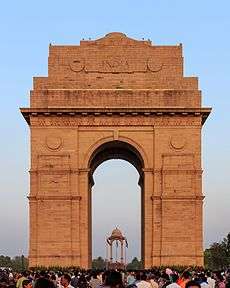
The India Gate is one of the most famous monuments in Delhi. Built in the memory of more than 90,000 Indian soldiers who lost their lives during the Afghan Wars and World War I.
-

Raj Ghat, the memorial to Mahatma Gandhi, it is a simple black marble platform that marks the spot of his cremation on 31 January 1948.
-

The Rajpath in Raisina Hill.
-

Ahinsa Sthal consist of a 13 ft 6 inches idol of Mahavira, Mehrauli
-
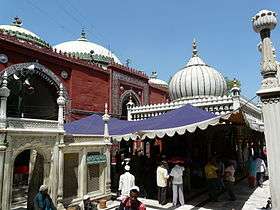
Nizamuddin Dargah and Jamaat Khan Masjid
-
Bara Gumbad and Mosque in the Lodhi Gardens.
-
Mausoleum called the Shisha Gumbad (glass dome) for its internal glass decorations at Lodhi Gardens.
-
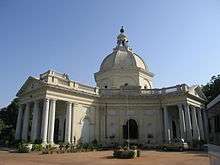
St. James' Church (1836), (Skinner's Church), at Kashmiri Gate, one of the oldest churches of Delhi.
See also
Outline of Tourism in India
- List of World Heritage Sites in India
- List of national parks of India
- List of lakes of India
- List of waterfalls in India
- List of State Protected Monuments in India
- List of beaches in India
- Incredible India
- List of Geographical Indications in India
- Medical tourism in India
- List of botanical gardens in India
- List of hill stations in India
- List of gates in India
- List of zoos in India
- List of protected areas of India
- List of aquaria in India
- List of forts in India
- List of forests in India
- Buddhist pilgrimage sites in India
- Hindu pilgrimage sites in India
- List of rock-cut temples in India
- Wildlife sanctuaries of India
- List of rivers of India
- List of mountains in India
- List of ecoregions in India
- Coral reefs in India
- List of stadiums in India
References
- 1 2 3 "Delhi Tour Packages". Tourism-delhi.com. Retrieved 2011-05-27.
- ↑ "Bangla Sahib Gurdwara Sikh shrine dedicated to Harkrishan Sahib the eighth Sikh Guru". Banglasahib.org. Retrieved 2011-05-27.
Further reading
- Sadia Dehlvi (2012). The Sufi Courtyard: Dargahs of Delhi. Harper Collins. ISBN 9350290952.
External links
- "India in One, Two or Three Weeks". New York Times. March 23, 2012.
| Wikimedia Commons has media related to Visitor attractions in Delhi. |